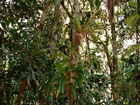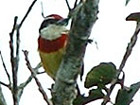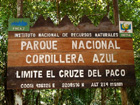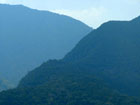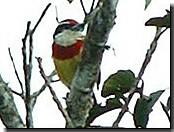|
|
|
|
Home | Trip Reports | Recent Sightings | Blog | Photographs | Phonescoping | Sounds & Sonograms | Drawings | Patches | Invertebrates
|
|
|
| The Day I Saw The Barbet |
That'll be the Scarlet-banded Barbet Capito wallacei from the Cordillera Azul in northeastern Peru!
15 August 2005
So what's so special about this bird then? The Scarlet-banded Barbet was only discovered in 1996 (and described in 2000) by Dan Lane and Dr. John O'Neill on a Louisiana State University Expedition to a remote corner of rainforest in Peru in a range of hills known as the Cerro Cinco Puntas. This finding was remarkable in many respects. While it resembles other barbets, its plumage is unique - boldly patterned with conspicuous red, yellow, black and white. The bird was found on an unnamed peak in an area which had never been surveyed or explored before due its remoteness. The cloud forest habitat favoured by the barbet is fairly small and restricted to a small altitudinal zone near the top of a mountain which has come to be known as Barbet Peak or Peak 1538. I was lucky enough to be working for several weeks in the Parque Nacional Cordillera Azul - Peru's newest national park - and even luckier to be on Barbet Peak after many days travel and field work from Contamana on the Rio Ucayali and Rio Cushabatay. So, I'll pick up the story on 13 August 2005 when, after several days in a peque-peque, my colleagues (Prof. James Mallet, Dr. Kanchon Dasmahapatra & Laura Roberts) and I finally left the boat behind to begin our trek to towards the peak. We camped that night on the bank of the Rio Cushabatay at Boca de Chambira and set off early next morning with two Inrena guardaparques (Agustine and Raul from Puesto de Control 106 and 16 respectively) and three bearers (Milton and his two brothers) to help us re-cut the trail and carry food and equipment. By lunchtime we reached Quebrada Paco after several hours of continuous walking. Although this stretch of the trek is fairly flat, the combined heat, humidity and a large rucksack made for less than a pleasant experience. However, this was nothing compared with next two days of continuous uphill struggling.
On the 14th we began the climb to the 1086 metre camp. After five hours of determined trekking, the occasional impressive vista and stop to gulp down some water, we reached Pucacurillo. The camp here showed signs from the few previous expeditions here. Feeling the effects of dehydration and the disheartening news that the nearest water was another 30 minutes walk away we resorted to acquiring some liquid from a nearby trickle/stagnant-looking pool. In what may have been a bit of overkill, the resulting water was filtered, boiled and treated with iodine. That night I slept like a log, troubled only by that feeling that any twitcher (not that I belong to that tribe of birders) knows - how bad would I feel, after having the extreme fortune to be here, to leave without laying eyes on the Capito? Tomorrow was the final ascent to the peak where this very special bird had hidden from the ornithological world for so long. The morning of the 15th dawned and my luck did not appear to be in as I missed a Green Jay near the tents. After an early breakfast it was back on the trail, stopping only to fill all the water bottles from the stream, located in a steep gully about 30 minutes from camp. With the park guards re-cutting the trail through the steep and dense rainforest it appeared that it had been a long time since anyone had walked this way. When it became apparent that we were ascending a ridge to the peak, the habitat dramatically changed to epiphyte-laden cloud forest with trees of reduced stature. Trailing behind the main group, I realised that if any barbets were flushed by them, then my chances of connecting with the barbet were reduced. I was the only birder in the group although most of the others were keen to see what all the fuss was about. With a one-track mind I struggled on to get to the front, stopping only to note some Blue-winged Mountain-Tanagers and Slate-throated Redstarts. It was here that I heard soft "brrrr" calls from two birds I was unable to locate. Catching up with my colleagues I found them talking excitedly - two of them had observed a Scarlet-banded Barbet. Taking the lead from this point and with my senses in a heightened state of alert, I searched along the trail for my very own barbet. Suddenly I was surprised to find the habitat opening out, scrub taking over from tree cover, and the open sky. We had reached the top!
Click here for a map of the locality
It was remarkable how small the cloud forest habitat was - probably only a couple of hundred metres in elevation around the peak looked suitable, and we had passed up through it so quickly. Taking a few photographs and then ignoring a canopy flock coming through, I headed back down to where today's barbet had been sighted. After an hour I was beginning to panic and some of the party were beginning to head back down. I tried to locate more of the soft "brrr" calls which I had heard earlier. They appeared to be uttered by some hidden birds which were also making tapping sounds on the branches. Suddenly Agustine came racing up the trail to tell me had seen five barbets! I was down at the spot in no time and very soon... there they were. A splendid pair of Scarlet-banded Barbets. Observing them call I realised I had been hearing them all along. Then, another pair. Yes, they are striking birds but so are many of the common birds in South America. What made these moments particularly special was the knowledge that very few people had shared the same experience of the species. And then a slightly uncomforting thought. The habitat here seems so small, perhaps even fragile, on the ridge of this peak - what is its future in the face of climate change? This year was one of the driest periods in recent times in the Amazon and we have all seen the reports in the news. I feel extremely fortunate to have seen the barbet and its magical habitat and thank everyone involved in this expedition.
Essential Reading... Dumb Luck: The Discovery of the Scarlet-banded Barbet by Dan Lane Birdlife International Press Release The Hunt for the Scarlet-banded Barbet by Barry Walker See the Scarlet-banded Barbet on film on the website of The Neotropical Birdclub
References... 1. O'Neill, John P. Daniel F. Lane, Andrew W. Kratter, Angelo P. Capparella & Cecilia Fox. 2000. A Striking New Species of Barbet (Capitonidae: Capito) from the Eastern Andes of Peru. The Auk 117 (3):569-577. 2. Clements, James F & Noam Shany. 2001. A Field Guide to the Birds of Peru. CA: Ibis Publishing Company. Lynx Edicions.
About | A-Z Index | Search this Website | Links | Ayrshire Bird Report | Ayrshire Bird Race | Biking & Birding to Work | Scarlet Banded-Barbet | Blog Index | Cycling | Ambient
|
|
|
© Fraser Simpson · www.fssbirding.org.uk |
|


